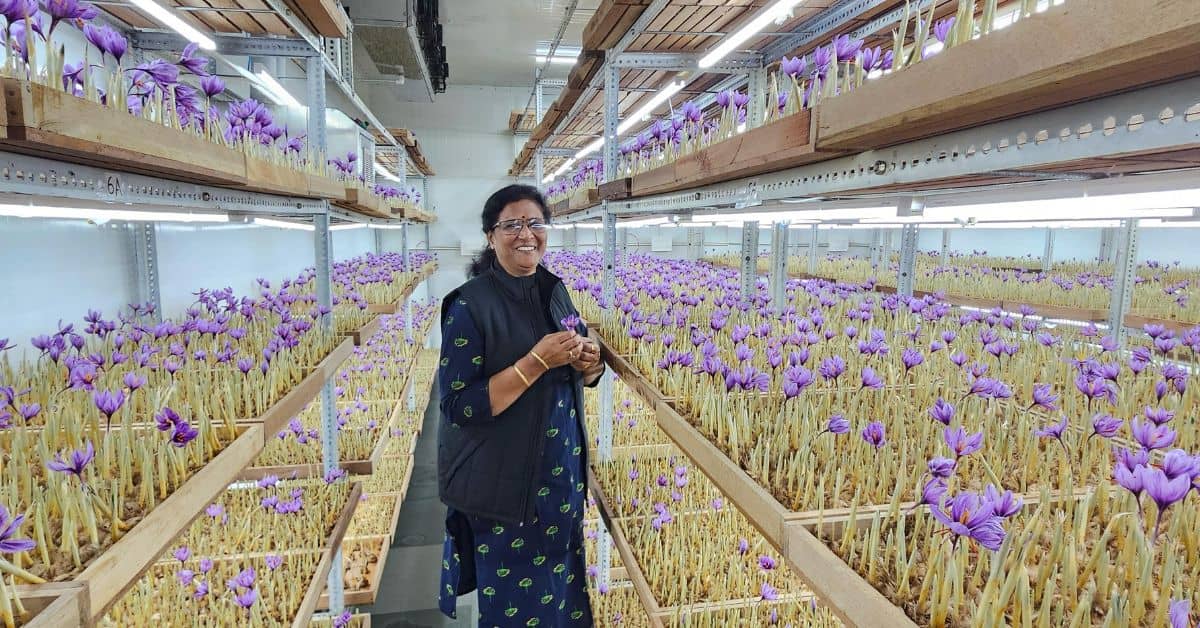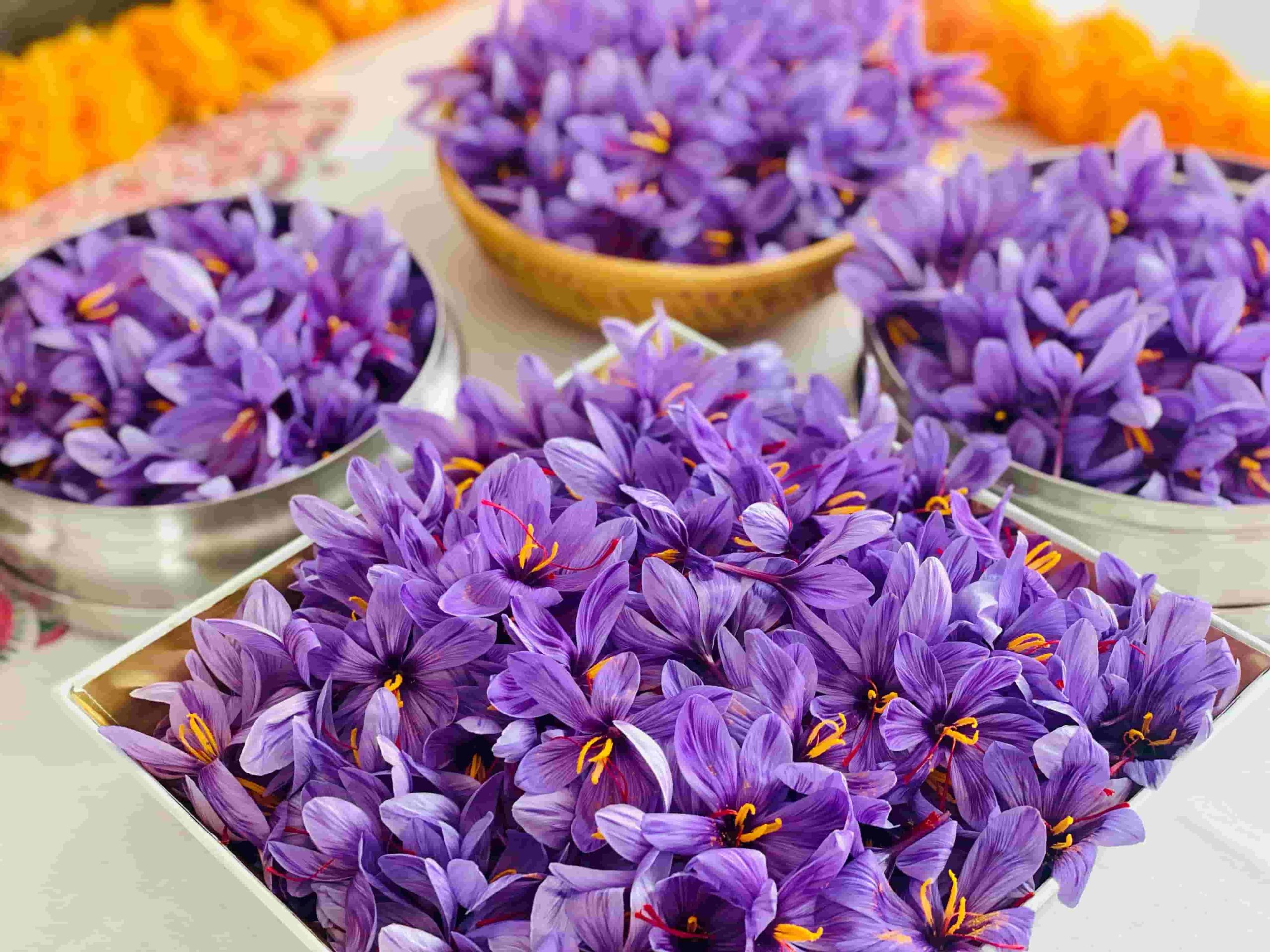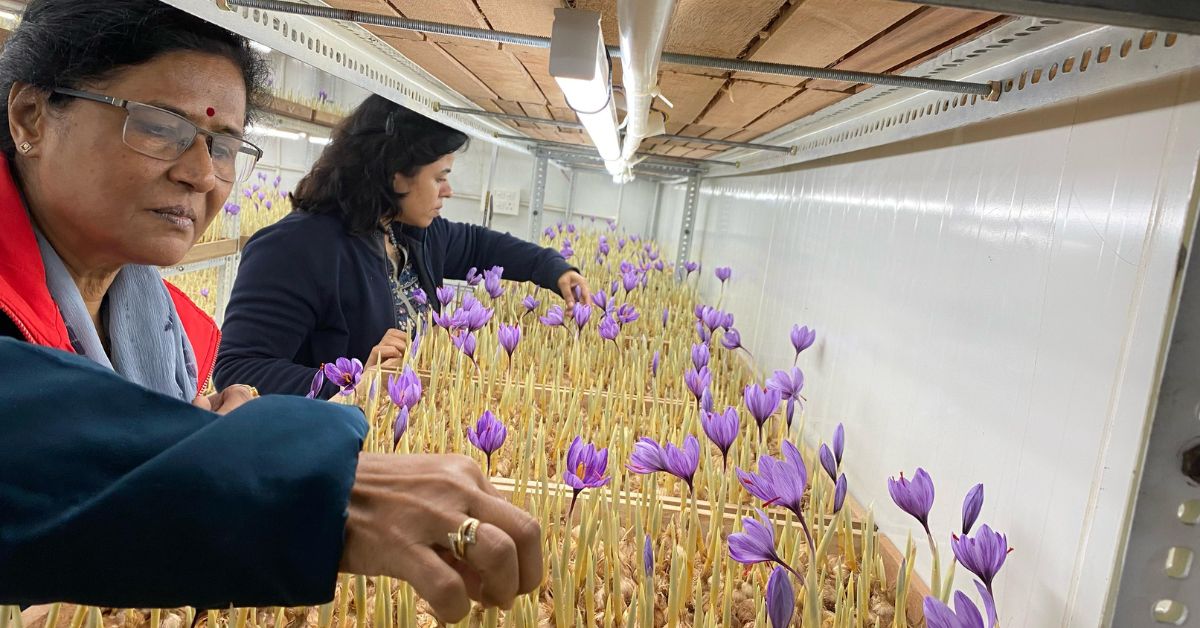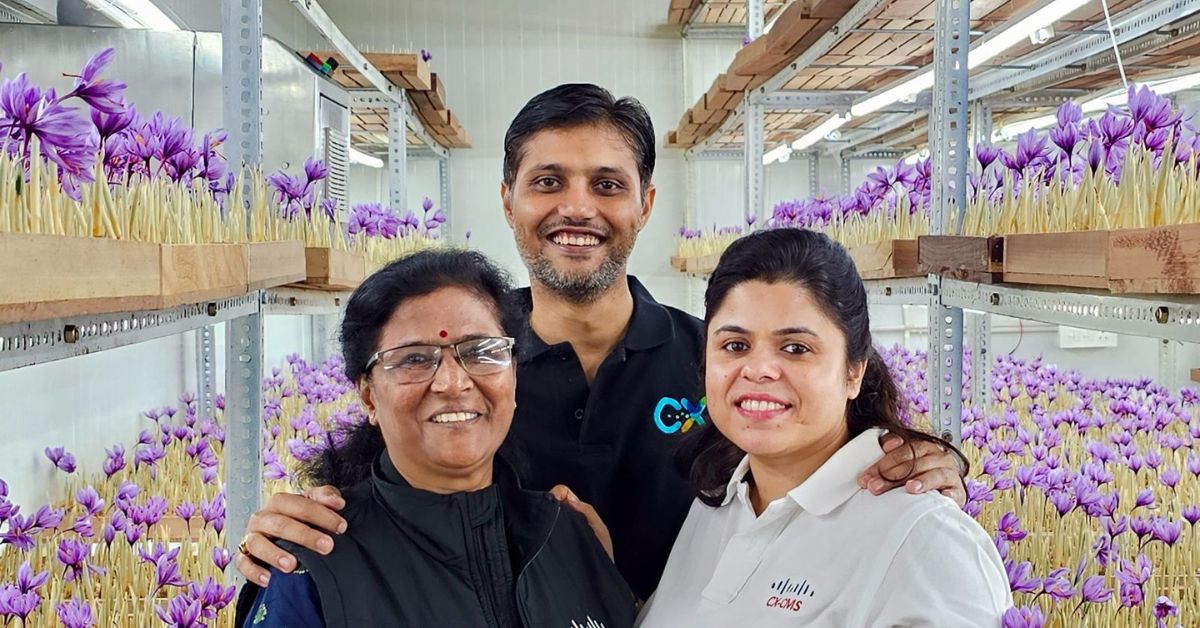In Might 2023, Shubha Bhatnagar initiated a moderately fascinating dinner desk dialog. She shared her dream of cultivating saffron indoors and offering employment to rural ladies within the close by villages. A homemaker, the 63-year-old was “freed from obligations” and wished to embark upon a journey of self-reliance by turning into an agriprenuer.
On the dinner desk have been two engineers: her son and daughter-in-law, and her husband, who runs a chilly storage enterprise. They have been intrigued by her thought and instantly began the best way to make her imaginative and prescient a actuality.
Conversations within the following weeks and months that adopted have been not concerning the on a regular basis mundanities, however moderately about how saffron could possibly be cultivated indoors and the way they might obtain the required weather conditions.
Saffron, a extremely valued spice, is completely grown in Kashmir, benefiting from its distinctive soil and climate situations. By trial and error, they replicated the weather conditions of Kashmir in a chilly storage room in Mainpuri utilizing IoT (Web Of Issues).
Thus, by integrating expertise, they planted the authentically sourced seeds within the chilly storage chamber in August 2023, yielding their first harvest roughly three months later. Named ‘Shubhavni SmartFarms,’ they commenced promoting their first produce of two kilograms of saffron earlier this yr. They’ve offered over Rs 8 lakh value of saffron and employed 25 ladies thus far.
Right here’s how Shubha achieved this outstanding feat.
A enterprise journey to Kashmir
After finishing her MA (Grasp of Arts) in Hindi from Shikohabad, Shubha obtained married and moved to Mainpuri. She spent the subsequent 40 years of her life caring for her two youngsters: a son and daughter, and later her grandchildren.

It was solely up to now few years that she began searching for avenues to start out a enterprise. “I wished to place my time and life to good use. Fortunately, I’m wholesome and able to do some laborious work. At this stage of life, I wish to discover some objective and which means to it,” shares Shubha.
As agriculture is a serious occupation in Mainpuri, she began doable choices of crops that could possibly be grown indoors, because of her husband’s enterprise as a result of chilly storage is a requirement for indoor farming.
“I might usually meet farmers and ladies who labored as helpers in fields. They’d a tricky time offering for his or her households and educating their ladies. I wished to make use of these ladies by way of no matter enterprise I started,” Shubha tells The Higher India.
She lastly shortlisted mushrooms and saffron after months of analysis and feasibility research, and determined to go forward with saffron.
Often called kesar in Hindi, saffron is likely one of the most costly spices globally. Iran holds the title of the most important producer of saffron, with India following swimsuit. Inside India, this spice finds cultivation completely in Jammu and Kashmir, owing to its beneficial local weather.
Shubha’s son Ankit began researching methods to develop the spice indoors utilizing aeroponics. He additionally seemed into the expertise and sensors wanted to observe the crop.

In the meantime, Shubha confronted a dilemma concerning procuring seeds or saffron bulbs. She wasn’t content material with merely ordering them from Kashmir with out assessing the standard and gaining insights from native farmers. To handle this, the household launched into a visit to Kashmir for per week, participating with farmers, immersing themselves within the cultivation course of, and studying the dos and don’ts immediately from the locals.
“We met about 25 to 30 farmers in Kashmir and spent many days with them. We wished to study concerning the sort of soil they use, the method of cultivating saffron, how lengthy it takes, and which temperatures saffron thrives in. We additionally purchased the bulbs from them,” says Ankit.
After coming again, Shubha arrange a chilly storage room of 560 sq. toes and began with 2,000 kg of saffron bulbs.
How do you develop saffron indoors?
After getting the saffron bulbs from Kashmir, which appear like garlic pods, step one was to dry them in a room and later aerate them for 3 days. They needed to be checked, cleaned and turned each few hours by hand, which is historically performed by ladies in Kashmir. Every seed was checked for moisture and decay, and any further pores and skin was eliminated by way of a course of referred to as silvering.

As soon as the seeds have been aerated, they have been positioned in a chilly room in vertical trays on racks. “There must be no water, moisture or humidity,” informs Ankit.
The bulbs began rising and buds emerged after just a few days. Then, the problem was to know when to supply gentle to the buds and at what temperature. Whereas the attractive valleys of Kashmir present the proper atmosphere which the buds take pleasure in, replicating them 1,200 km away was an enormous activity.
“In Kashmir, the bud receives gentle solely when it comes out of the soil. Studying at what stage that occurs and offering the appropriate temperature was the largest problem. After we began, we positioned bulbs in 18 racks in six rows and supplied totally different temperatures and light-weight to every rack to evaluate which one labored one of the best,” shares Ankit.
To realize this, Shubha and Ankit went by way of 10 years of saffron manufacturing information in Kashmir. They discovered that one of the best harvest was achieved in 2015-16 and replicated the temperatures of that yr. They developed a programme utilizing IoT gadgets and sensors to take care of the appropriate situations and a managed setting by way of aeroponics.
In about 60 days, the attractive purple flower emerged and was prepared for harvest!

Every saffron flower has three elements — the stigma, which is used for consumption; the stamen, which is yellow and used within the textile business; and the petals, that are purple and used within the textile business too.
As soon as harvested, the stigma, extra generally often called saffron, should endure drying and packaging. Shubhavni sells one gram of saffron for Rs 750. They’re at present conducting on-line gross sales, with complete gross sales amounting to Rs 8 lakh to date.
Whereas Ankit developed the system, it’s Shubha who maintains it and oversees the enterprise. She realized concerning the expertise employed, laptop dealing with, the artwork of gross sales, and far more. She smiles as she says, “There’s no age restrict to studying.”
She now plans to multiply manufacturing by tripling the world beneath manufacturing. She additionally needs to attempt for 2 harvests in a yr, whereas sometimes just one harvest is finished.
The benefit of rising saffron indoors
Shubha is likely one of the few folks main the shift in direction of indoor agriculture, particularly in saffron. Many farmers in Kashmir too are making this change, as local weather change has severely hampered their saffron manufacturing. A report in The Wire states that the world beneath saffron cultivation in Kashmir has lowered from 5,707 hectares in 1996 to 1,116 hectares in 2020.

Indoor farming isn’t threatened by local weather change, soil points or developments close by. It’s basically foolproof if one masters the artwork of sustaining the appropriate temperature and settings.
One other benefit is the area wanted for cultivation. “A farmer would sometimes sow 2,000 kg of saffron in 1.5 acres of land, whereas we’re capable of do the identical in 560 sq. toes,” Ankit explains.
Shubha needs to create a saffron “revolution” and assist extra folks develop the spice indoors. By her enterprise, she is at present offering employment to over 20 ladies in Mainpuri, as the method of rising saffron is laborious. Proper from drying the bulbs to plucking every stigma, drying, and packing them, it requires cautious and exact work.
For girls like Geeta Devi, it presents a reliable earnings. At 40 years outdated, she’s a mom of 5 and the first supplier for her household. Beforehand, she laboured within the fields beneath the scorching solar, struggling to make ends meet. Work was inconsistent, and earnings was meagre, she recollects. Nevertheless, since becoming a member of Shubhavni Farms final July, her state of affairs has improved.
“I benefit from the work right here and introduced in 20 extra ladies. We have been taught all the pieces about saffron cultivation and did all the pieces from aeration to conserving it clear and eradicating the stamen from the flower. We’re working in a snug setting as a substitute of bearing the cruel warmth. We receives a commission not less than Rs 100 extra per day,” says Geeta.
It’s Shubha’s dream to supply an everyday supply of earnings to extra ladies like Geeta and be sure that their youngsters have a greater future. And to each lady wanting to start out a enterprise, she has one message, “By no means underestimate your self and your desires.”
“I wish to consider that we’re not a patriarchal society. We’re equally succesful. Self-reliance provides immense confidence and provides you a chance to encourage others. Even beginning a small enterprise will enhance your happiness degree and morale,” says Shubha.
At this time, the Bhatnagar household’s dinner desk conversations are about how the harvest has been and the way they might obtain two harvests in a single yr!
Edited by Pranita Bhat, Photographs Courtesy Ankit Bhatnagar
